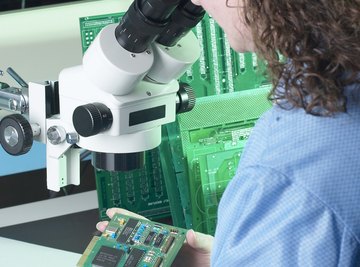
One of the most important functions of living cells is to produce the proteins necessary for an organism’s survival. Proteins give shape and structure to an organism and, as enzymes, regulate biological activity. To manufacture proteins, a cell needs to read and interpret the genetic information stored in its deoxyribonucleic acid, or DNA. The sites of cellular protein synthesis are the ribosomes, which can be free or bound. The importance of the free ribosome is that protein synthesis begins there.
DNA and RNA
DNA is a long molecular chain composed of alternating sugar and phosphate groups. One of four possible nitrogen-containing nucleotide bases -- A, C, T and G -- hangs off each sugar. The sequence of the bases along the DNA strand determines the sequence of amino acids that form proteins. Ribonucleic acid, or RNA, transmits a complementary copy of a portion of a DNA molecule -- a gene -- to ribosomes, which are tiny granules composed of RNA and protein. RNA resembles DNA except that its sugar groups contain an extra oxygen atom and it substitutes the U nucleotide base for DNA’s T base. The ribosomes create proteins according to the information stored in the messenger RNA, or mRNA.
Complementary Coding
The rules for transcribing DNA to RNA specify a correspondence between bases on the gene and bases on the mRNA. For example, an A base in a gene specifies a U base in the mRNA strand. Similarly, a gene’s T, C and G bases specify A, G, and C bases, respectively, in mRNA. The genetic information contained in mRNA takes the form of triplets of nucleotide bases called codons. For example, the DNA triplet TAA creates the RNA triplet UTT. The DNA and RNA strands therefore contain complementary, yet unique, information encoded in the sequence of nucleotide bases. Almost every triplet codes for a specific amino acid, although a few triplets specify the end of a gene. Several different triplets can code for the same amino acid.
Ribosomes
The cell manufactures ribosomes directly from ribosomal RNA, or rRNA, encoded by specific DNA genes. The rRNA combines with proteins to form large and small subunits. The two subunits only join during protein synthesis. In a prokaryotic cell -- that is, a cell without an organized nucleus -- the ribosome subunits float freely within the cell liquid, or cytosol. In eukaryotes, enzymes in a cell’s nucleus build ribosome subunits. The nucleus then exports the subunits to the cytosol. Some of the ribosomes may temporarily bind to a cell organelle called the endoplasmic reticulum, or ER, when building proteins, while other ribosomes remain free as they synthesize proteins.
Translation
A free ribosome’s smaller subunit grabs hold of an mRNA strand to begin protein synthesis. The larger subunit then hooks on and begins translating each mRNA codon. This entails exposing and positioning each mRNA codon so that enzymes can identify and attach the amino acid corresponding to the current codon. A molecule of transfer RNA, or tRNA, with a complementary anti-codon locks into the larger subunit, its designated amino acid in tow. Enzymes then transfer the amino acid to the growing protein chain, expel the spent tRNA for reuse, and expose the next mRNA codon. When finished, the ribosome releases the new protein and the two subunits dissociate.
References
About the Author
Based in Greenville SC, Eric Bank has been writing business-related articles since 1985. He holds an M.B.A. from New York University and an M.S. in finance from DePaul University. You can see samples of his work at ericbank.com.
Photo Credits
Hemera Technologies/AbleStock.com/Getty Images
